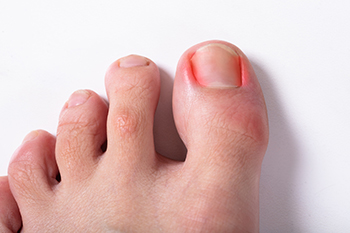Babies Can Get Ingrown Toenails
Tuesday, 18 October 2022 00:00
An ingrown toenail generally causes pain and discomfort, and it can be unsettling to a parent if their child develops this foot condition. It occurs as a result of a toenail that grows into the skin, instead of over it. Babies' toenails are soft and curved, and can easily grow into the side of the skin, and if this happens, it will typically become red and swollen. An infected ingrown toenail can produce pus or yellow fluid, and it may cause pain while walking or crawling. Soaking your child’s foot in warm water may bring mild relief, and it may help to gently massage the nail and surrounding area. The chances of getting an ingrown toenail may be reduced when effective prevention methods are practiced. These can include trimming the nails straight across, and avoiding cutting them too short. Additionally, gently pulling the skin away from the nail may be done after a bath, when the nails are soft. If you would like more information about how to protect your child from getting an ingrown toenail, please confer with a podiatrist.
Ingrown toenails may initially present themselves as a minor discomfort, but they may progress into an infection in the skin without proper treatment. For more information about ingrown toenails, contact one of our podiatrists of Family Foot Care. Our doctors can provide the care you need to keep you pain-free and on your feet.
Ingrown Toenails
Ingrown toenails are caused when the corner or side of a toenail grows into the soft flesh surrounding it. They often result in redness, swelling, pain, and in some cases, infection. This condition typically affects the big toe and may recur if it is not treated properly.
Causes
- Improper toenail trimming
- Genetics
- Improper shoe fitting
- Injury from pedicures or nail picking
- Abnormal gait
- Poor hygiene
You are more likely to develop an ingrown toenail if you are obese, have diabetes, arthritis, or have any fungal infection in your nails. Additionally, people who have foot or toe deformities are at a higher risk of developing an ingrown toenail.
Symptoms
Some symptoms of ingrown toenails are redness, swelling, and pain. In rare cases, there may be a yellowish drainage coming from the nail.
Treatment
Ignoring an ingrown toenail can have serious complications. Infections of the nail border can progress to a deeper soft-tissue infection, which can then turn into a bone infection. You should always speak with your podiatrist if you suspect you have an ingrown toenail, especially if you have diabetes or poor circulation.
If you have any questions, please feel free to contact our offices located in Valatie and Albany, NY . We offer the newest diagnostic and treatment technologies for all your foot care needs.



